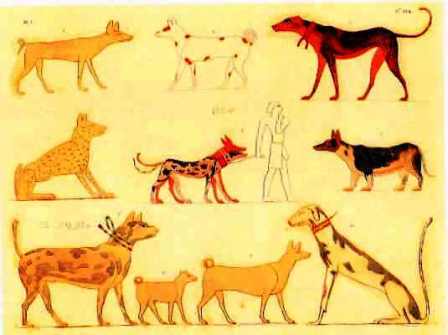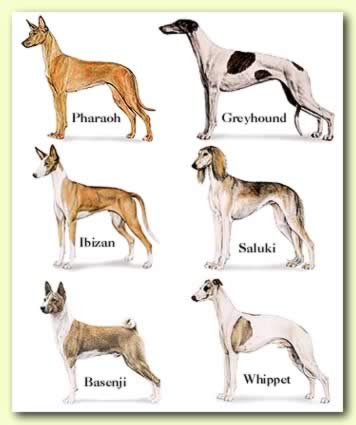Types of Egyptians Pets
The ancient Egyptians had numerous different types of pets – monkeys, ducks, geese, pigeons, hoopoes, falcons, cats, dogs and even ferrets (to keep the granaries free of vermin). Egyptian Dogs, while often depicted as hunting with the master or as watch dogs, but they were never shown as an animal to be petted. Known to the Egyptians as the sound-wordie, the sound of barking, or as tsm, hound, they were given individual names and were often buried with their masters.

Types of Egyptians Dogs
The types of dogs the Egyptians had were related to the basenji, the Saluki, the greyhound and maybe even the mastiff and dachshunds. In the Old Kingdom (about 2686-2181 BC) the greyhound (Egyptian: Tsm – long narrow muzzle, nearly straight facial profile, long neck, and limbs) was very common. From the Middle Kingdom (about 2025-1700 BC) onwards there is attested a greater variety of dogs (different types of ears, ring-tailed, saber-formed tails).
Ancient Egypt is known to have had some of the oldest dogs that the world is now familiar with. These Egyptian Dogs were once buried with the dead and almost portrayed as gods all over the walls of tombs and pyramids.
 The Egyptian Dog Breeds include the Saluki and the famous Greyhound. The Saluki originated in the Middle East and was bred to hunt jackal, gazelle, hare, and fox. The Ibizan Hound is an ancient sight hound depicted on the tomb of Tutankhamon, the Ibizan hound has the ability to jump great heights, is agile, and now works as a scent hound and a family dog.
The Egyptian Dog Breeds include the Saluki and the famous Greyhound. The Saluki originated in the Middle East and was bred to hunt jackal, gazelle, hare, and fox. The Ibizan Hound is an ancient sight hound depicted on the tomb of Tutankhamon, the Ibizan hound has the ability to jump great heights, is agile, and now works as a scent hound and a family dog.
We even know many ancient Egyptian dog’s names from leather collars as well as stelae and reliefs. They included names such as Brave One, Reliable, Good Herdsman, North-Wind, Antelope and even “Useless”. Other names come from the dogs color, such as Black, while still other dogs were given numbers for names, such as “the Fifth”.
Many of the names seem to represent endearment, while others convey merely the dog’s abilities or capabilities. However, even as in modern times, there could be negative connotations to dogs due to their nature as servants of man. Some texts include references to prisoners as “the king’s dogs”.